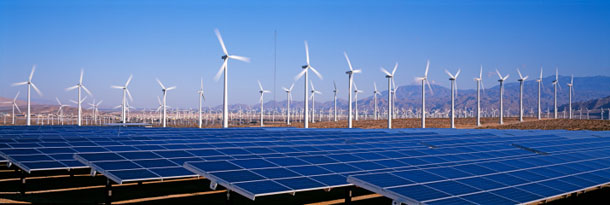Last spring, the global renewable energy company Invenergy announced that it would install the first three “intelligent” wind turbines equipped with storage batteries and connected to the Industrial Internet at the Goldthwaite wind farm in Central Texas.
That’s why GE engineers developed a 2.5 megawatt wind turbine equipped with a system of sensors and algorithms that gather and analyze weather, turbine and grid data.
The machine, whose rotor sweeps a circle 120 meters in diameter – almost twice the wingspan of a Boeing 747, can forecast electricity production over the next hour and store excess power in the battery.
The machine, whose rotor sweeps a circle 120 meters in diameter – almost twice the wingspan of a Boeing 747, can forecast electricity production over the next hour and store excess power in the battery.
Few people know it, but the grid can’t always swallow wind electricity as fast as it comes up. That’s why GE engineers developed a 2.5 megawatt wind turbine equipped with a system of sensors and algorithms that gather and analyze weather, turbine and grid data.
The machine, whose rotor sweeps a circle 120 meters in diameter – almost twice the wingspan of a Boeing 747, can forecast electricity production over the next hour and store excess power in the battery. “Turbines used to turn their blades out of the wind,” says Keith Longtin, general manager for wind products at GE’s renewable energy business. “That revenue was gone with the wind, but now we have predictable power.”
The U.N. Intergovernmental Panel on Climate Change's latest report, which explores ways to cut carbon emissions, put the world on notice. Despite efforts in the United States, Europe and developing countries such as China to ramp up energy efficiency and renewable energy, global carbon emissions have been increasing at a much faster clip than they were just a few decades ago. To avoid the worst of the worst, IPCC scientists say emissions will have to be reduced 40 percent to 70 percent by 2050 and warn that we only have a 15-year window to reverse course.
Wind, Solar More Affordable
Unlike new reactors, the cost of solar and wind has dropped dramatically. Solar panel prices have plummeted more than 75 percent since 2008, and the cost of generating electricity from wind turbines declined more than 40 percent over the past three years, sparking a construction boom. Last year, solar installations in the United States amounted to a record 5.1 gigawatts, boosting the national total to nearly 13 gigawatts -- enough to power nearly 2.2 million typical American homes. And by the end of December, there were enough wind turbines across the country to power 15.5 million homes and cut annual electric power sector carbon emissions by 4.4 percent.
Given solar and wind's exponential growth, experts see tremendous potential. The Department of Energy's National Renewable Energy Laboratory (NREL), for example, projects that wind and solar could produce 15 percent of U.S. electricity by 2020, 27 percent by 2030, and 50 percent by 2050.
Still, naysayers harp on the fact that wind and solar power are intermittent. The sun doesn't always shine, they say, and the wind doesn't always blow. That may be true, but it's not a deal-breaker. Studies by NREL and electricity grid operators in the United States and Europe conclude that larger contributions from solar and wind would not create significant technological problems or impose higher costs.
The machine, whose rotor sweeps a circle 120 meters in diameter – almost twice the wingspan of a Boeing 747, can forecast electricity production over the next hour and store excess power in the battery. “Turbines used to turn their blades out of the wind,” says Keith Longtin, general manager for wind products at GE’s renewable energy business. “That revenue was gone with the wind, but now we have predictable power.”
The U.N. Intergovernmental Panel on Climate Change's latest report, which explores ways to cut carbon emissions, put the world on notice. Despite efforts in the United States, Europe and developing countries such as China to ramp up energy efficiency and renewable energy, global carbon emissions have been increasing at a much faster clip than they were just a few decades ago. To avoid the worst of the worst, IPCC scientists say emissions will have to be reduced 40 percent to 70 percent by 2050 and warn that we only have a 15-year window to reverse course.
Wind, Solar More Affordable
Unlike new reactors, the cost of solar and wind has dropped dramatically. Solar panel prices have plummeted more than 75 percent since 2008, and the cost of generating electricity from wind turbines declined more than 40 percent over the past three years, sparking a construction boom. Last year, solar installations in the United States amounted to a record 5.1 gigawatts, boosting the national total to nearly 13 gigawatts -- enough to power nearly 2.2 million typical American homes. And by the end of December, there were enough wind turbines across the country to power 15.5 million homes and cut annual electric power sector carbon emissions by 4.4 percent.
Given solar and wind's exponential growth, experts see tremendous potential. The Department of Energy's National Renewable Energy Laboratory (NREL), for example, projects that wind and solar could produce 15 percent of U.S. electricity by 2020, 27 percent by 2030, and 50 percent by 2050.
Still, naysayers harp on the fact that wind and solar power are intermittent. The sun doesn't always shine, they say, and the wind doesn't always blow. That may be true, but it's not a deal-breaker. Studies by NREL and electricity grid operators in the United States and Europe conclude that larger contributions from solar and wind would not create significant technological problems or impose higher costs.



No comments:
Post a Comment